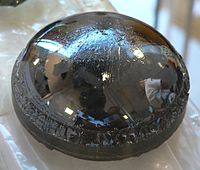
Photo from wikipedia
Electron paramagnetic resonance (EPR) spectroscopy was used to study the point defects in 2 × 1017–1019 cm−3 C-doped GaN substrates grown by hydride vapor phase epitaxy. The intensity of an isotropic signal with… Click to show full abstract
Electron paramagnetic resonance (EPR) spectroscopy was used to study the point defects in 2 × 1017–1019 cm−3 C-doped GaN substrates grown by hydride vapor phase epitaxy. The intensity of an isotropic signal with g = 1.987 ± 0.001 increased monotonically with the carbon concentration, indicating that the EPR signal represents a carbon-related defect. In each sample, the signal intensity increased under illumination with photon energy greater than 2.75 eV, and the photo-induced signal decreased with subsequent illumination at 0.95 eV. A second signal, well-documented to be a shallow donor, appeared along with the g = 1.987 signal in the most lightly doped samples. The appearance of the donor confirms that the photo-induced increase is caused by excitation of an electron to the conduction band and implies that a defect level for the carbon-related center is about 1 eV above the valence band edge, consistent with temperature-dependent Hall measurements.
Journal Title: Journal of Applied Physics
Year Published: 2018
Link to full text (if available)
Share on Social Media: Sign Up to like & get
recommendations!